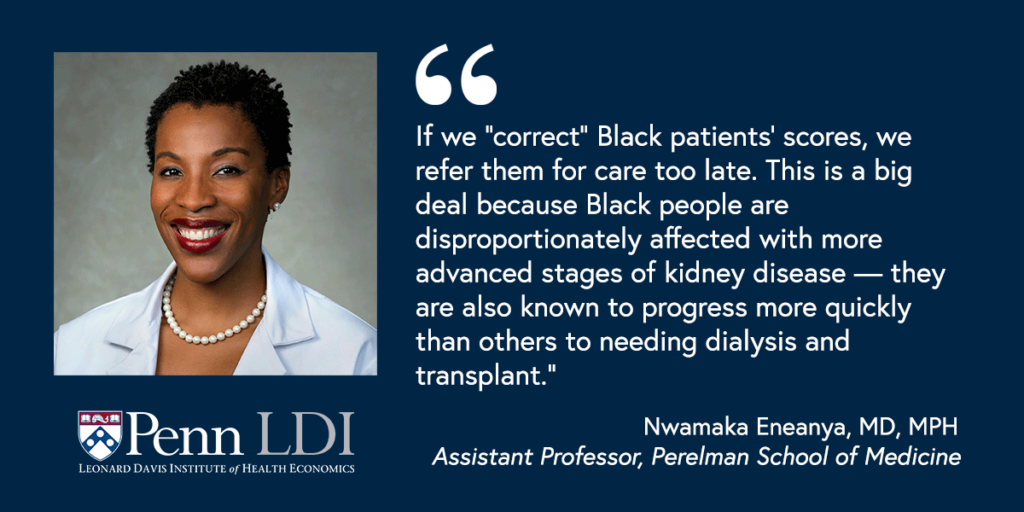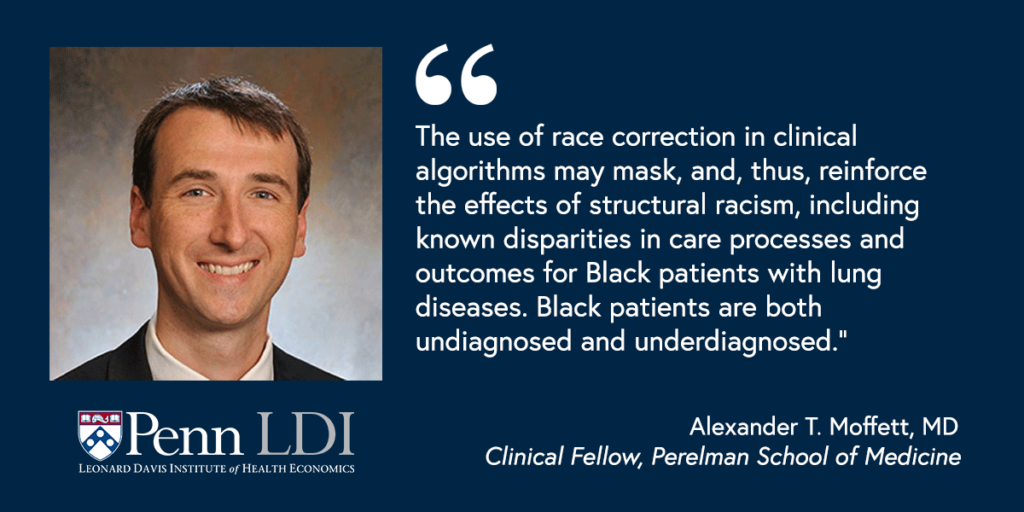
HIV is Not a Crime: The Case for Ending HIV Criminalization
Outdated Laws Target Black and Queer Lives in Over 30 States, Fueling a Deadly Disease
Blog Post
Slowly and painstakingly, the structures that perpetuate racism in clinical medicine are starting to be dismantled. Researchers are raising questions about the validity and effects of using longstanding “corrections” for Black race in interpreting clinical test results. And this research is changing guidelines and clinical practice.

In the most recent example, LDI Fellows Rebecca Hamm, Sindhu Srinivas, and colleagues analyzed the effects of an algorithm that uses different antenatal hemoglobin cutoffs for Black patients, resulting in a lower likelihood of being diagnosed and treated for anemia in pregnancy. In a research paper published in July 2021, they showed that this differential treatment threshold by race could increase the likelihood that Black women present to labor and delivery with anemia, which may ultimately affect maternal and neonatal outcomes. That same month, based on this work, the University of Pennsylvania Health System changed its guidelines to define and treat antepartum anemia with the same threshold for all people. And in August, the American College of Obstetrics and Gynecology changed its guidelines to recommend that that the same threshold for anemia be used for all pregnant women, citing Hamm’s analysis.

In another example, LDI Fellows Amaka Eneanya and Peter Reese published a commentary in JAMA in 2019 that challenged the widespread use of race to adjust the principal measure of kidney disease, known as the estimated glomerular filtration rate (eGFR). They noted that this adjustment for Black race in the eGFR could lead to underdiagnosing and undertreating chronic kidney disease in Black patients, which has the potential to reduce access to specialty care, clinical trials, and kidney transplantation. In a subsequent study, Eneanya, Reese and colleagues showed that about one-third of Black patients could be reclassified as having more severe kidney disease if the race modifier were removed from the equation. Eneanya sits on a joint American Society of Nephrology-National Kidney Foundation task force that is now reassessing the use of race in diagnosing kidney disease. In the meantime, a number of health systems have stopped using the eGFR race modifier, including Mass General, the University of Washington, NYU Langone, and the University of Pennsylvania Health System.

In work presented at the American Thoracic Society conference in May 2021, a team of LDI Fellows described the impact of a Black race adjustment in pulmonary function tests (PFTs), which is standard in clinical practice. In an analysis of more than 14,000 PFTs, Alex Moffett, Amaka Eneanya, Scott Halpern, and Gary Weissman found that removing the adjustment led to a significant increase in the diagnosed prevalence and severity of pulmonary disease among Black patients. They intend to continue their work to assess how adjusting for race in PFTs may be promoting the inequitable allocation of medical resources to Black patients with pulmonary disease.
These are not isolated instances of racial corrections in medical tests. In 2020, a commentary in the New England Journal of Medicine provided a partial list of 12 race-adjusted algorithms across medical specialties.
You may wonder, as I did, how and why these race-based adjustments got into clinical algorithms. All too often, these “corrections” are rooted in misapplied science, false assumptions of biological differences, and a legacy of racism. Different anemia cutoffs for Black women? The proximal reason was an 1993 report by the Institute of Medicine, which noted that “[t]he average hemoglobin concentration of healthy blacks is lower than that of other races.” A Black modifier for diagnosing kidney disease? It stems from a study in 1999 that found differences in serum creatinine between Black and white participants, falsely ascribing these differences to biological distinctions in muscle mass. Adjustments in PFTs? The purported differences in lung function by race have been built into pulmonary function measures for at least a century.
What these examples share is willingness to use race as a proxy for biological differences that has been unexamined for far too long, even though we now understand that race is a social construct. Does that mean we should never use race to guide clinical care? In JAMA, Eneanya and colleagues laid out a four-part test for assessing the justifiability of using race to guide clinical care:
Using this test, it is likely that many existing race-based treatment decisions would, and should, fail. In Lancet earlier this year, Dorothy Roberts, noted Penn scholar of race, gender, and the law, called for abolishing race correction as part of the broader struggle to end racism in medicine. She summarized the issue eloquently, saying:
Race is not a natural grouping that is misused by bigoted laypeople but used beneficially by unbiased doctors. Race was invented in order to implement racism. The idea that human beings are naturally divided into biologically distinct races was developed in 18th-century scientific justifications for European conquest, dispossession, and enslavement of other peoples. In the 19th century, US doctors promoted the racial concept of disease to legitimise slavery as based on innate distinctions rather than on white supremacy. Anti-racism in medicine therefore requires more than weeding out bias in the minds of individual physicians; it requires ending how medicine is structured to promote racist ideas, policies, and practices.
It is painstaking work to change clinical practices that have emerged over decades, and carry the legacy of racism over centuries. But researchers are having an impact, both locally and nationally, and the pace of change is accelerating. There’s no going back now.


Outdated Laws Target Black and Queer Lives in Over 30 States, Fueling a Deadly Disease

Selected for Current and Future Research in the Science of Amputee Care

Penn LDI Seminar Details How Administrative Barriers, Subsidy Rollbacks, and Work Requirements Will Block Life-Saving Care

Top Experts Warn of Devastating Impact on Community Safety Efforts

A Gathering of a Health Services Research Community Currently Under Siege

1,000+ Detail the Latest Health Services Research Findings and Insights